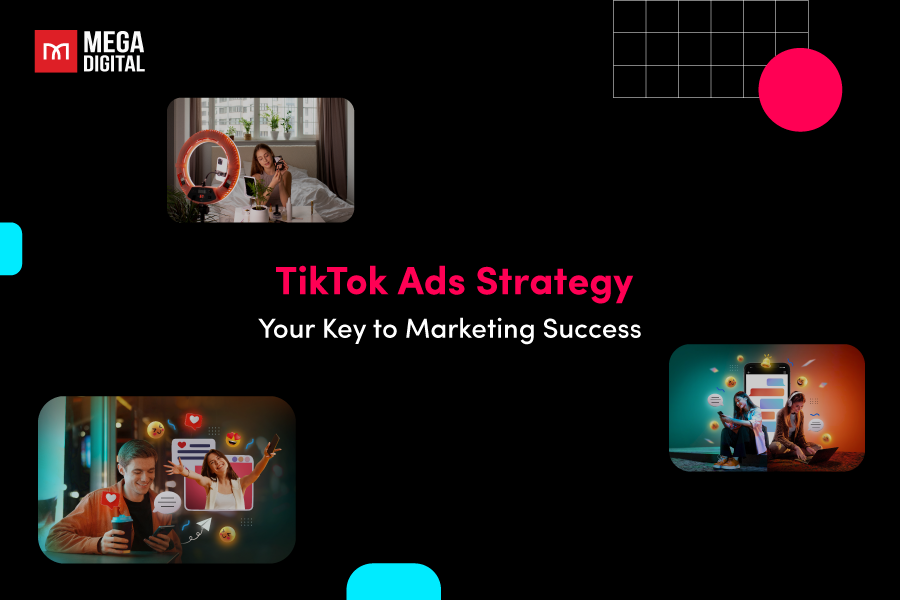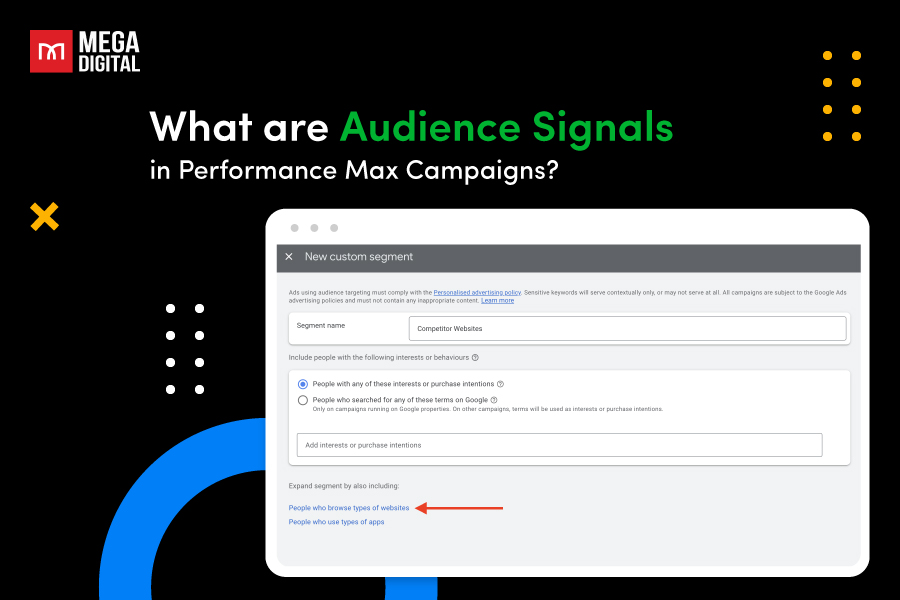Social to search arbitrage is a dynamic digital marketing strategy that exploits the expansive user bases of social media platforms to drive traffic to monetized search feeds. This guide explores all you need to know about social media arbitrage, explaining its mechanisms and offering practical insights on how to make money from it.
QUICK SUMMARY
- Social to search arbitrage = buy traffic from platforms like Facebook, TikTok, YouTube → redirect to search feeds → earn from the margin.
- Why it works: massive reach, precise targeting, high engagement, and cross-platform synergy.
- Two campaign setups: 1-click flow (direct) and 2-click flow (via pre-lander) — each with pros and cons.
- In this guide, you’ll learn best ad networks, real cost breakdowns, common rookie mistakes, and how to optimize campaigns for profit.
What is Social to Search Arbitrage?
Social to search arbitrage involves purchasing low-cost traffic from social media platforms (Meta, YouTube, X, etc.) and redirecting it to a search feed page. The primary goal is to take advantage of the cost difference between what you pay for social media traffic and what you earn from search engine traffic.
Why Social to Search Arbitrage?
While social media arbitrage is not the only search arbitrage method available, what makes it such a tempting option?
Wide Reach
With billions of active users across platforms like Facebook, Instagram, TikTok, and YouTube, social media offers an unparalleled reach. This vast user base allows you to tap into diverse demographics and interests, ensuring your ads have the potential to reach a wide audience, increasing the chances of higher traffic and conversions.
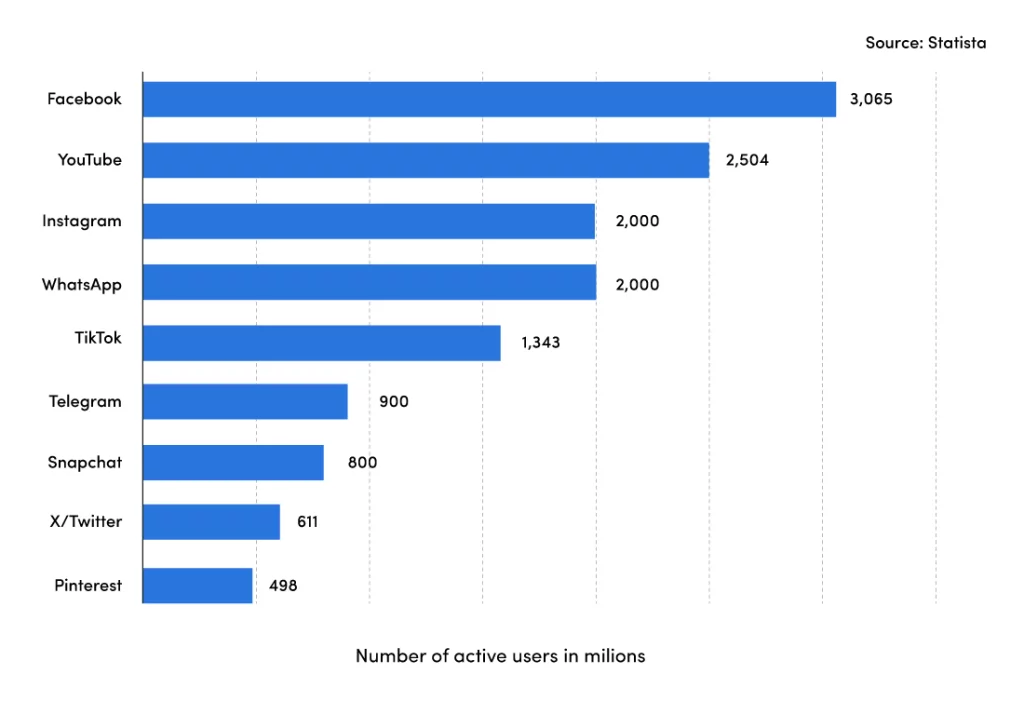
Source: Statista
Targeting Capabilities
On certain platforms, you can target users based on demographics, interests, behaviors, and even life events. For example, Facebook offers several targeting options like Custom Audiences, Lookalike Audiences, etc., while YouTube ads targeting options include Keywords Targeting, Topic Targeting, and so on.
Engagement Potential
Social media users are highly engaged with content, making them more likely to interact with ads. Platforms like TikTok and Instagram have exceptionally high engagement rates, which can lead to more effective ad campaigns.
Cross-Platform Synergy
Using social media for search arbitrage allows for cross-platform synergy. For example, you can run a coordinated campaign across Facebook, Instagram, and YouTube to reinforce your messaging and maximize your reach. Consistent exposure across multiple platforms can enhance brand recall and drive better performance.
Social to Search Arbitrage Mechanism
The fundamental mechanism of social to search arbitrage is similar to that of search arbitrage. The key focus here is how to source traffic from social media platforms. While there are many ways you can acquire social media traffic, the most common methods are through organic posts, via paid ads, and through affiliate marketing.
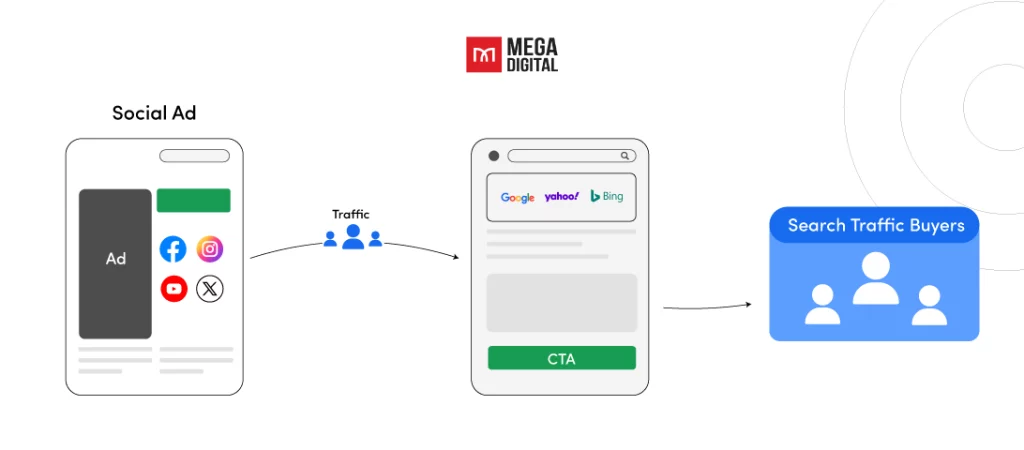
Organic traffic is rarely used in search arbitrage because it doesn’t generate much profit due to its small scale. Affiliate marketing isn’t preferred either because it’s hard to track and measure its effectiveness.
Paid advertising, however, is the most popular method for social to search arbitrage campaigns. It’s scalable and cost-effective, making it highly effective. Paid ads come in various formats and placements, allowing marketers to fully exploit their potential.
To make it easier to picture, imagine a marketer who runs a Facebook ad campaign targeting users interested in travel. The ad directs users to a search feed focused on travel deals. The marketer pays $0.8 per click on Facebook, while the search feed earns $1.5 per click from advertisers. With a conversion rate of 10%, the marketer generates 100 clicks from 1,000 impressions, costing $80 and earning $150 from the search feed. This results in a profit of $70.
Best Social Ad Networks to Source Traffic From
Each social media platform offers unique advantages for traffic sourcing in arbitrage campaigns. Depending on your budget, goals, and target audience, you can choose whichever platform best suits your needs. Here are the notable metrics of the top platforms for social to search arbitrage:
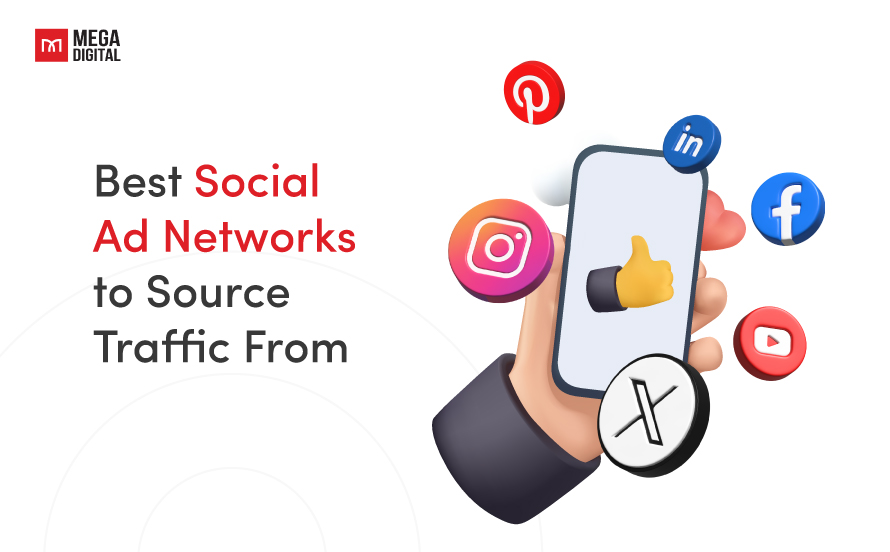
Facebook, the world’s largest social media platform with over 2.8 billion monthly users, offers powerful advertising tools ideal for search arbitrage campaigns. Its precise targeting capabilities allow businesses to drive highly relevant traffic to monetized search feeds, maximizing ROI. The platform’s diverse ad formats, including image and video ads, cater to various engagement strategies essential for effective search arbitrage on Facebook.
Average CPC: $0.97
Instagram, with over 1 billion monthly users, focuses on photo and video content. Features like Stories, IGTV, and Reels make it ideal for brands to showcase products and engage with customers. Instagram’s advertising tools allow precise targeting, enhancing marketing effectiveness.
Average CPC: $1.20
YouTube
Having an astonishing 2+ billion monthly users, YouTube, is the world’s leading video-sharing platform. It supports various ad formats, including skippable and non-skippable ads, making it a powerful tool for reaching wide audiences through video content. YouTube also supports integration with Google Ads, which can enhance targeting and analytics for your campaign.
Average CPC: $3.21
X (Twitter)
Twitter is widely used for news, public conversations, and customer engagement. With 330 million monthly users, the platform is known for real-time updates and concise 280-character tweets. Advertising options like promoted tweets and trends help businesses reach targeted audiences and join trending discussions.
Average CPC: $0.38
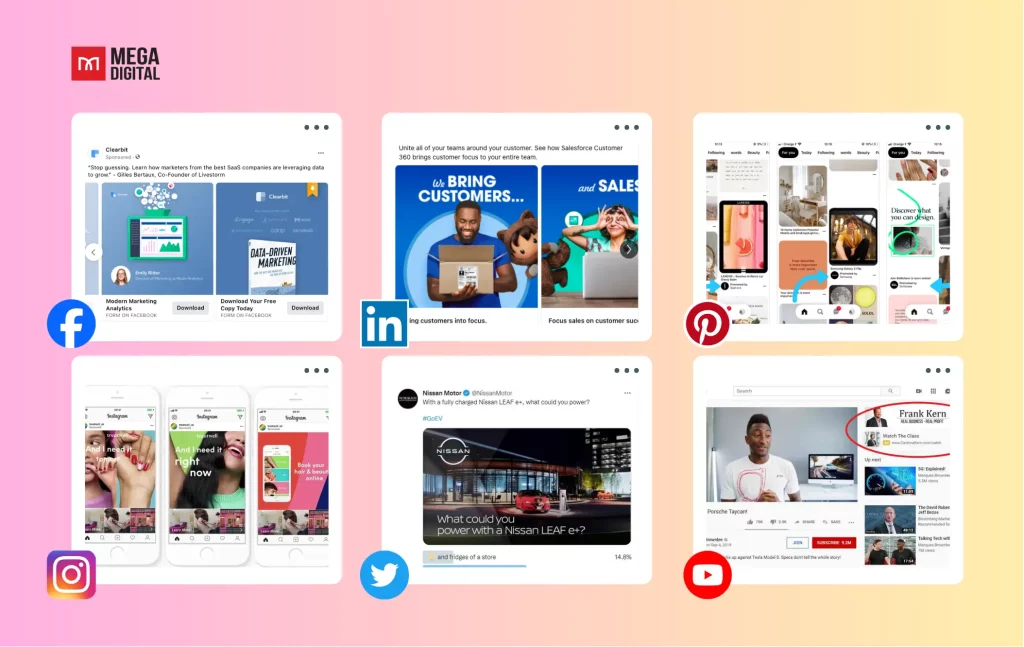
Distinguished as the largest professional networking platform, LinkedIn, with 774 million members, is ideal for business professionals to connect and share content. Its advertising formats, such as sponsored content and message ads, are tailored for B2B marketing, making it perfect for reaching a professional audience.
Average CPC: $5.26
The best visual discovery platform, Pinterest, currently has roughly 450 million monthly users looking for ideas and inspirations, mostly on home decor, fashion, cooking, and DIY projects. Promoted pins and video pins offer businesses unique advertising opportunities to reach users actively seeking ideas and inspiration.
Average CPC: $1.50
TikTok
With over 1.7 billion global users in 2025, TikTok stands out for its short-form video content and fast virality. The platform has the highest engagement rate among social media networks, especially popular with Gen Z and Millennials. Its diverse ad formats such as In-Feed Ads, Top View, and Branded Content allow advertisers to drive massive traffic to monetized search feeds.
TikTok also provides advanced targeting options including interests, behaviors, hashtags, and lookalike audiences, making it a top choice for sourcing affordable yet high-quality traffic.
Average CPC: $1.00
>>> Read more: Search Arbitrage with TikTok: How to Monetize with Ease!
Costs of Running Social Media Arbitrage
A total estimated monthly budget could fall around a few thousand dollars, typically a minimum of $3–5000, for a low-end campaign (minimal ad spend, basic creative, and free tools).
A higher-end campaign would require a budget of tens of thousands of dollars due to the costs of high ad spend, professional creative development, premium tools, and expert management.
Running a successful social media arbitrage campaign involves several costs. A detailed cost breakdown looks something like this:
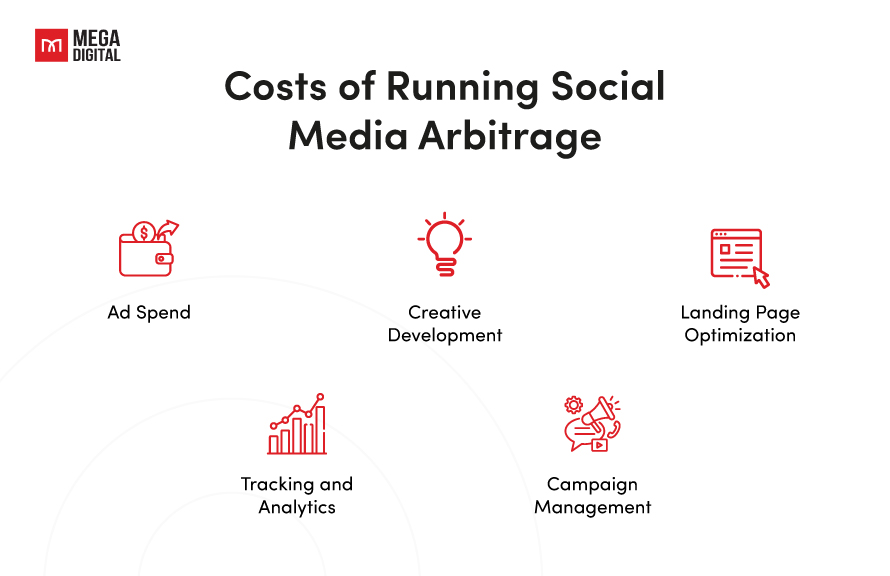
Ad Spend
The primary cost varies based on the platform, targeting options, and competition. For example, a Facebook ad campaign might cost around $0.97 per click, while LinkedIn ads could cost $5.26 per click.
Creative Development
In case you cannot create your own creative assets and need to outsource, there will be costs associated with creating compelling ad content, including design, copywriting, and video production. Typically, these costs can range from $500 to $5,000, depending on the complexity and quality of the content.
Landing Page Optimization
Expenses related to designing and maintaining effective landing pages. You can expect to spend anywhere from $100 to $1,000 per month for relevant tools and services.
Tracking and Analytics
Subscription fees for tools that monitor and analyze campaign performance. The most popular options are:
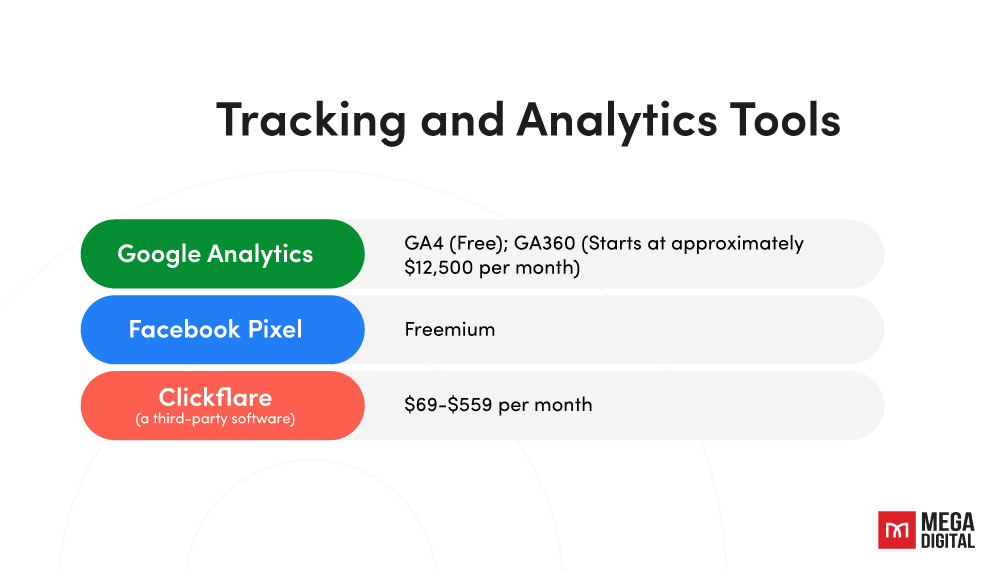
Campaign Management
Time and resources spent on managing and optimizing campaigns. This could involve hiring a digital marketer or agency, costing between $1,000 and $5,000 per month depending on the level of service and expertise.
How to Setup a Social to Search Arbitrage Campaign?
Setting up a social to search arbitrage campaign involves choosing the right flow to direct traffic from social media ads to monetized search feeds. Here’s how you can set up campaigns using the 1-click flow and 2-click flow methods:
Steps to Set Up a 1-Click Flow Campaign
The 1-click flow is the simpler of the two methods. It takes users straight from the social media ad directly to the Search Engine Results Page (SERP).
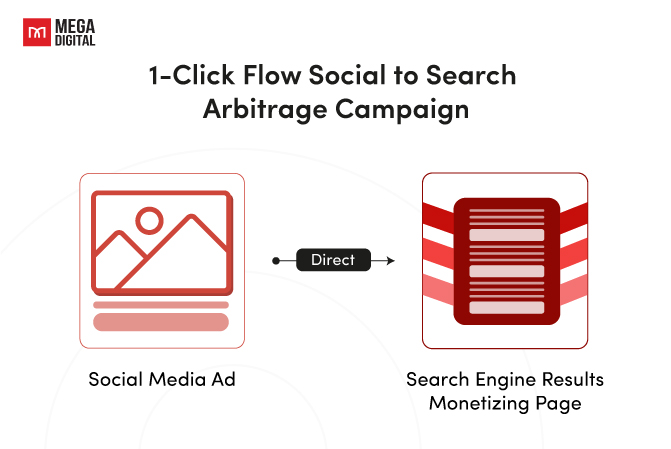
Step 1: Create a Social Ad Campaign
First, you need to ensure you have an ad account to access advanced features. Then, have your ad creatives prepared and ready. Create high-quality, engaging ad content with strong CTAs to encourage clicks.
Step 2: Set Up Basic Tracking Tools
Implement basic tracking tools such as Facebook Pixel or Google Analytics to monitor ad performance.
Step 3: Build Campaign Links
Typically, you must manually create campaign links for the 1-click flow to guide users from your social media ad directly to the SERP generated by your search feed provider. Be sure to customize the domain and parameter information to fit your case.
While a 1-click flow campaign is less challenging to build, it is not without its cons. Understading the advantages and drawbacks of this campaign type can help you determine if it’s right for you.
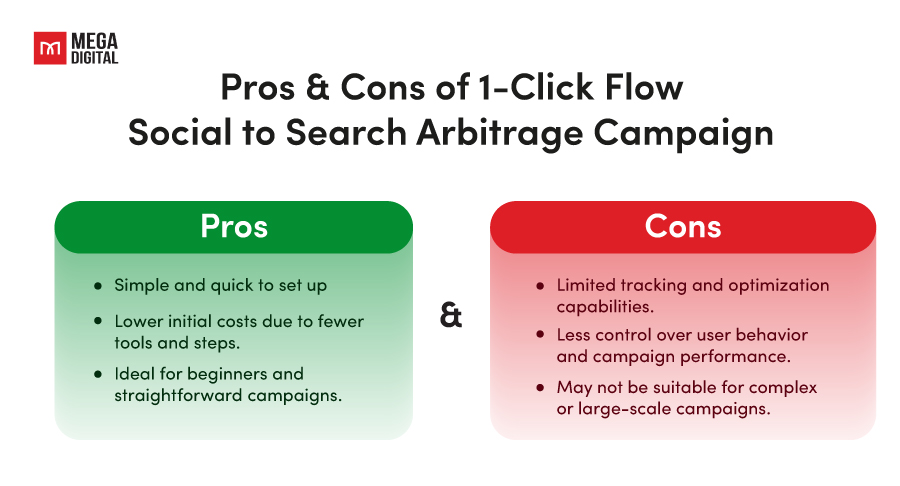
Steps to Set Up a 2-Click Flow Campaign
The 2-click flow involves an additional step where users are directed to a pre-landing page (also known as a parked domain) before reaching the SERP. This method is more advanced, but with greater efforts comes greater profitability as you can generate revenue from both the pre-landing page and the SERP.
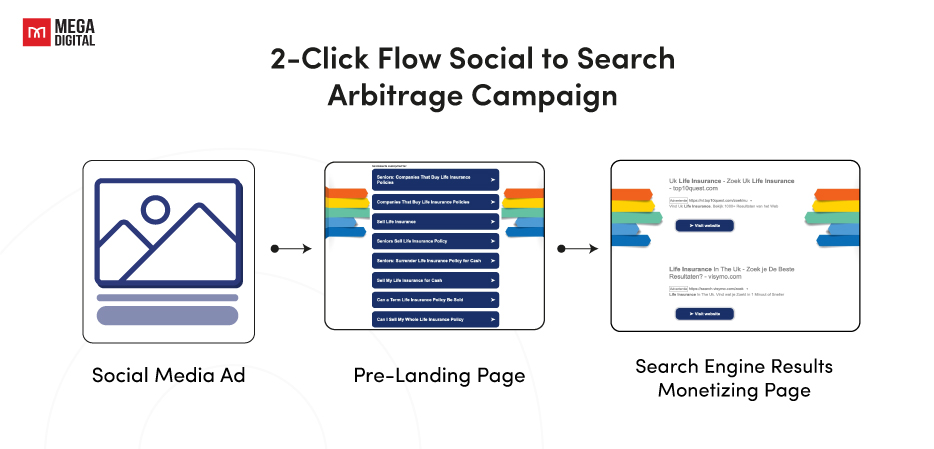
Step 1: Create a Social Ad Campaign
The first step is similar to that of the 1-click flow campaign, where you set up your ad account, such as a Facebook ad account, and develop your ad assets.
Step 2: Set Up Advanced Tracking Tools
Implement advanced tracking tools such as ClickFlare, Voluum, or RedTrack. These tools provide detailed insights into user behavior and campaign performance.
Step 3: Design an Optimized Pre-Landing Page
Create a pre-landing page that users visit after clicking your ad and before reaching the SERP. This page should be relevant to the ad content, load quickly, and be optimized for user engagement. It can capture user information, provide additional content, or include further CTAs.
Mobile optimization is also of utmost importance because as of 2024, mobile users account for over 60% of the internet traffic. If your pre-landing page fails to capture mobile users, you will lose significant traffic.
Step 4: Build Campaign Links and Set Up Tracking
Generate your campaign URLs using your chosen tracking platform. These URLs should direct users first to the pre-landing page and then to the SERP. Ensure tracking parameters are set up to capture detailed data on user interactions.
What pros and cons does a 2-click flow social to search arbitrage campaign have that differs it from a 1-click flow campaign? Let’s have a look!
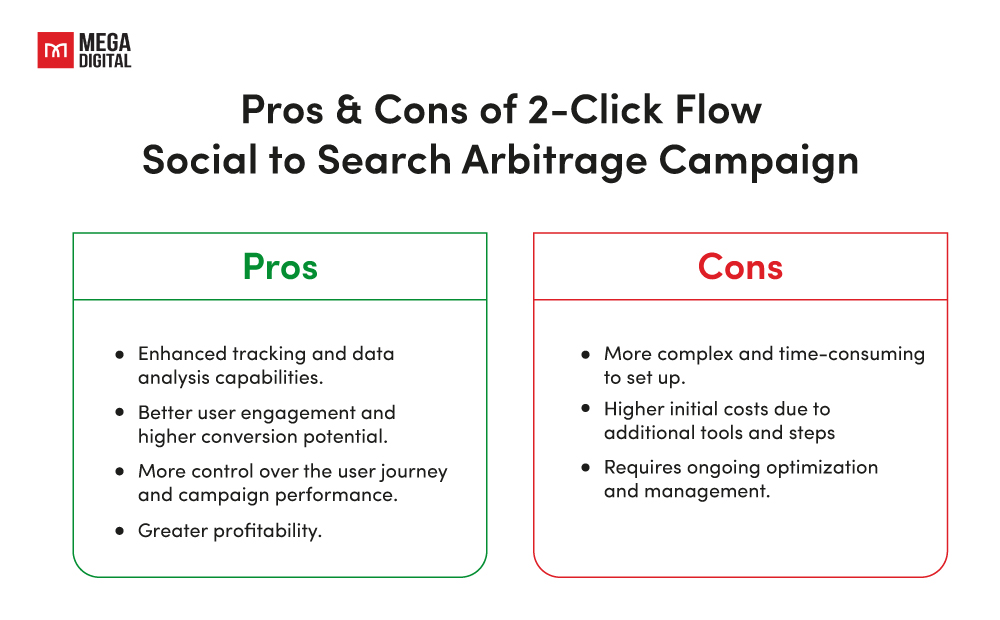
Common Rookie Mistakes of Social Media Arbitrage
Navigating the complexities of social media arbitrage can be challenging, especially for beginners. It’s easy to make mistakes that can obstruct your campaign’s success. Here, I have highlighted some common rookie mistakes and offer practical solutions to help you avoid them and run a more effective campaign.
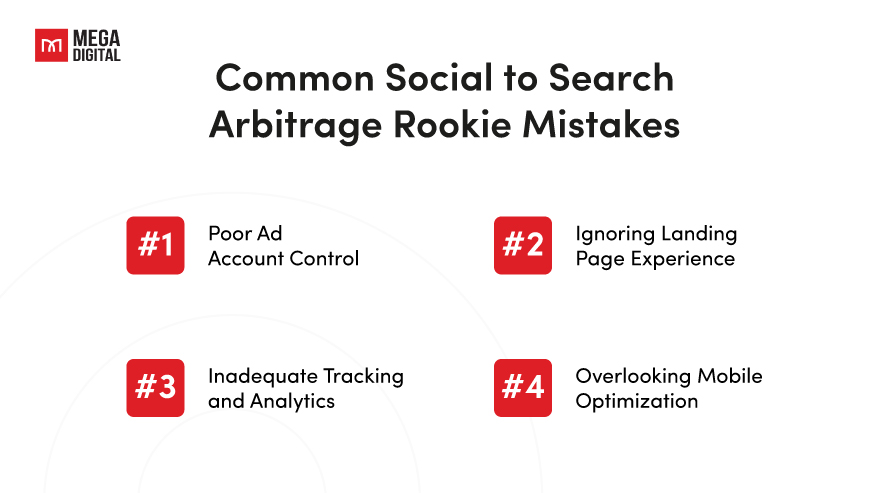
#1 Poor Ad Account Control
Creating an ad account on any social media platform is a piece of cake, but you will most likely bump into many advertising obstacles while running your social media arbitrage campaign. Notable challenges include limited ad spend, ads rejections, and account suspension due to policy or community guideline violation.
Solution:
To alleviate this issue, it is highly recommended that you use agency ad accounts, for example, a TikTok agency account. To rent agency ad accounts, find reputable and reliable agencies, such as Mega Digital, for comprehensive advertising solutions.
#2 Ignoring Landing Page Experience
Sending traffic to a poorly designed or irrelevant landing page can result in high bounce rates. If users don’t find the landing page appealing or useful, they will leave quickly.
Solution:
Ensure the landing page is optimized for user experience. It should be relevant to the ad content, load quickly, and be easy to navigate. A/B test different landing page designs to find the most effective layout.
#3 Inadequate Tracking and Analytics
Not using proper tracking and analytics tools can lead to a lack of insight into campaign performance. Without detailed data, it’s difficult to identify what’s working and what isn’t.
Solution:
Implement robust tracking and analytics tools to monitor every aspect of the campaign. Use tools like Google Analytics, Facebook Pixel, and other third-party software such as Clickflare or Voluum, to track clicks, conversions, and user behavior.

#4 Overlooking Mobile Optimization
Neglecting mobile users can result in lost opportunities, as a significant portion of social media traffic comes from mobile devices. If the landing page or search feed isn’t mobile-friendly, users will have a poor experience.
Solution:
Ensure all aspects of the campaign, from ads to landing pages, are optimized for mobile devices. Use responsive design and test on various devices to ensure a seamless experience.
>>> Read more: What is Native to Search Arbitrage? How to Gain Profit?
Author’s Take
Social media arbitrage can be very profitable for marketers who are willing to put in the effort to improve their campaigns. By learning how it works, using the right tools, and always tweaking your strategies, you can make a lot of money. Keep in mind that success in social to search arbitrage takes patience, ongoing learning, and attention to detail.







